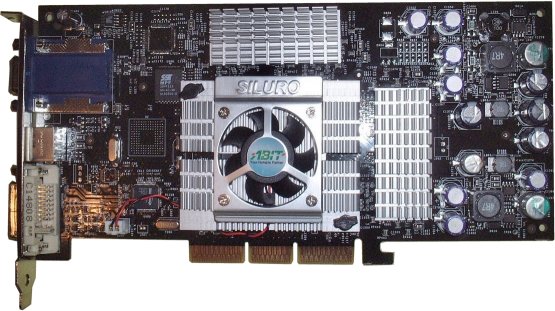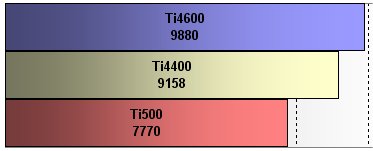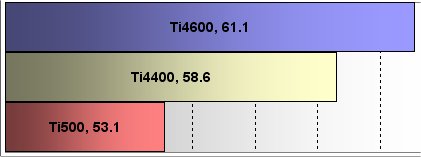ABIT Geforce 4 TI4600
IntroductionEarlier on this year Hexus.net took a look at the reference Ti4600 board from NVidia. The next month they were available for the consumers to buy from the usual manufacturers. I am going to take a look the fastest 3d accelerator card currently available from ABit, they have named it the Siluro Ti4600.
As the name suggests this card comes with NVidias latest and greatest chipset named the Ti4600. The Geforce4 Ti series comes in three flavours, the Ti4200, Ti4400 and the Ti4600. For an in-depth look at specifics with these chipsets please take a look here, where Hexus.net's very own Ryszard takes us through the technical aspects of the chipset.
The ABit Siluro Ti4600 graphics card stays faithful to the reference design up to a point. The only difference is the inclusion of a custom core heatsink and fan combo along with passive heatsinks for the on board memory. You can see all this in the picture below:

In the picture you can see the range of ports the card is installed with. These are D-Sub Output, DVI output and the S-Video/Composite TV-Out. One of the stressed features of the GF4 series is the 1024x768 resolution on the TV-Out. This provides a lot higher quality than has previously been seen by NVidia cards.
Here's a quick run down of the Siluro's features:
-
NVidia GF4 Ti GPU
-
128mb DDR SDRAM
-
AGP 4x/2x
-
TV-out
-
nFiniteFX II Engine
-
DVI-I
-
nView
-
Accuview
These are all the standard Ti4600 chipset features. To steal material from Ryszard (as he does it so well) the Ti series include the highly pimped Accuview anti-aliasing logic, the TMDS and HDTV logic and nView display tech and the LMA II crossbar. You can see all this in detail from the Hexus NVidia review sample seen here.
Specification
The formal specification of the card is quite impressive. These numbers and details are a direct quote from ABit:
- NVIDIA GeForce4 Ti 256-bit 3D GPU
- 128MB high-speed 128bit DDR RAM memory
- AGP 2x/4x with Fast Writes and AGP Texturing Support
- NVIDIA nFiniteFX II Engine
- Dual Programmable Vertex Shaders
- Advanced programmable Pixel Sahders
- 4 dual rendering pipelines, 8 texels per clock cycle
- NVIDIA Lightspeed memory Architecture (LMA) II
- NVIDIA Accuview Antialiasing
- NVIDIA nView
- High-quality HDTV and DVD playback
- Support TV-Out
- DVI-I Supports LCD Monitors
- DVI-I to VGA Adapter Supports dual CRT displays
The dual display capabilities of this card are impressive to say the least. Because of the dual pumped 350mhz RAMDAC's the card can run two monitors at two different refresh rates and two different resolutions. Previous to this you could only find this facility in high end graphics hardware.
Installation
You get the usual range of cables, wires and driver CD. Only thing missing is some sort of free gaming software. However in the past I never actually used any games software I acquired with a graphics card and leaving it out does help to keep the price down. However extra games often appeal to people. You can see the complete bundle below:

To install this card I had to take out my Asus GeForce3 Deluxe card that had stood me so well. Installation was simplicity itself. Dropped it in the AGP socket of my ABit KR7A-Raid motherboard, switched on and booted up. Previous to putting the card in I downloaded detonator driver version 27.70 which I had heard was the best driver for the GeForce4 range of cards. So when getting into windows at a nice 640x480 resolution I immediately installed the new drivers and when prompted to, rebooted.
Everything went smoothly during the next boot and I immediately set my resolution to 1600x1200x32 with 85hz refresh rate. The picture was crystal clear and nothing noticeably different at this stage. The display settings were exactly the same as the GeForce3 accept for the addition of the nView menu. You can see this below:

For the purposes of testing I left all the settings at default except for turning V-Sync off to keep it so that any tests are not restricted in the frames per second department.
Performance
To test the performance of this card I will use the usual Hexus benchmarking programs. Each benchmarking score will be compared to scores already taken here at Hexus. It will be put up against Visiontek's Ti4400 graphics card and the Gainward Golden Sample Ti550 both of them at stock clock speeds.
The benchmarking software used will be 3DMark2001SE, Serious Sam 2, Quake 3 v1.30 and Aquamark v2.3. Each benchmark will be run 3 times for accuracy and the computer rebooted between each benchmark for consistency. I would like to stress here that the scores for the GF4 Ti4400 and the GF3 Ti500 will be on a slightly different computer specification than the one I am currently testing as I don't personally have access to these cards. But for the sake of consistency I will keep the computer specifications as similar as possible.
As I previously mentioned the settings for the graphics card will remain strictly at default except for forcing V-Sync off in both DirectX and OpenGL. I used RivaTuner V2.0 RC10.2 for this and will do later for the overclocking of the card.
ABit Siluro GeForce4 Ti4600 test rig:
- ABit KR7A-Raid KT266A Chipset, Socket A AMD DDR Motherboard
- Unlocked AMD Athlon XP1500+ Processor (1.33ghz, 10x133)
- 2 x 256mb Kingmax PC2700 DDR Memory Modules (CAS2)
- ABit Siluro GeForce4 Ti4600 128mb
- Adaptec 39160 PCI SCSI Dual Channel U160 controller
- Atlas II 10,000rpm 36.5gb U160 SCSI Disk
- 2 x Seagate 10,000rpm 18.5gb U2W SCSI Disks (Software Raid 0 config)
- Sony IDE CDRW
- Creative Soundblaster Audigy Player Retail
- Detonator XP 27.70 NVidia Drivers
GeForce4 Ti4400 & GeForce3 Ti500 test rig:
- Epox 8K3AW, KT333 Chipset, Socket A AMD DDR Motherboard
- Unlocked AMD Athlon XP1500+ Processor (1.33ghz, 10x133)
- 2 x 256mb Samsung PC2700 DDR Memory Modules (CAS2)
- Visiontek Xtasy GeForce4 Ti4400 128mb
- Gainward Ti550 GeForce3 Ti500 64mb
- Adaptec 39160 PCI SCSI Dual Channel U160 Controller
- 2 x 73gb Seagate Cheetah U160 10,000rpm SCSI Disks
- Plextor 12/10/32s SCSI CDRW
- Pioneer 6x Slot-load SCSI DVD
- Creative Soundblaster Audigy Player Retail
- Detonator XP 27.42 NVidia Drivers
Software Used on both systems:
- Windows XP Professional Build 2600.xpclient.010817-1148
- Aquamark V2.3
- Quake3 v1.30
- 3DMark 2001 Professional Second Edition
- Serious Sam: The Second Encounter Demo
As you can see there are only 2 major discrepancies one is the motherboard used. The chipsets are very similar except the KT333 is slightly more up to date and supports DDR333 (PC2700) ram. The other main difference is the Detonator driver version used. Other than that, the setups are virtually identical.
3DMark2001 Second Edition Pro
To start with I will use the most common and
everyone's favourite benchmarking program, 3DMark2001SE. MadOnion did a
good job with this benchmark and this is the reason it has become one of
the most popular benchmarking tools. It stresses most aspects of the
system with the heaviest weighting being the graphics card and the CPU.

As expected the Ti4600 chipset pulls out a very comfortable lead over the other two cards. This is the first time I have seen a graphics card almost break that magical 10k barrier at default. That is no less than stunning performance. As we have said constantly here at Hexus, anything above a 6000 score at default with 3DMark2001SE is a system more than capable of playing any currently available game with ease. The component that is letting the benchmark down is the CPU, to test this theory I set the CPU to XP1900 speeds (1.6ghz) and ran the bench again. You can see the benchmark here. The score attained was 10921, this is breaking the 10k barrier and then some. Almost reaching 11k and still at default is simply overwhelming. This quite obviously shows that the GF4 is sitting around waiting for the CPU to pass information to it, no overclocking of the GF4 Ti4600 chipset would be needed at all for a extremely high 3DMark2001 score.
Serious Sam 2: The Second Encounter - The
Valley Of The Jaguar
Like
3DMark this test stresses all aspects of the system with significance on
the graphics card and CPU. With this benchmark I will run it at 3
different resolutions. First 1600x1200 then 1280x1024 and then finally
1024x768. Lets take a look at the results when compared to the other
cards:

Obviously there is some discrepancy between the results. Unfortunately because the other two cards scores that are shown here aren't on precisely the same computer specification the results are somewhat off. The difference could be because of many different factors, the major two being the motherboard and the driver version. Of course there are other things to consider such as bios settings, ram timings and ram speeds. However I find it strange that this occurrence hasn't shown up in any of the other benchmarks I have performed. You can see that every other benchmark is achieving the expected range of results. I think its safe to say we can disregard these results from a comparison point of view.
Quake 3 - v1.30
Next we come to the infamous
Quake 3 benchmark. This is a standard benchmark that most reviews include
and is right up there in popularity with 3DMark2001. Quake 3 has been
scoring incredible marks even with the GeForce3, now using a GeForce4 we
should expect nothing less than stunning. Lets see how the new NVidia
chipset performs in the real gaming world. As before the resolutions are
1600x1200 then 1280x1024 and then finally 1024x768.

In a word. Impressive. In this real world benchmark the GeForce4 Ti series of card is setting new standards and breaking old records. As expected the low resolution benchmarks are high, but where the GF4 Ti chipset shines through is at the higher resolutions. Only 20fps have been dropped between 1024x768 to 1600x1200. In fact the GF4 Ti4600 score is higher than the Ti500s low resolution score. I would simply have been impressed to see a default benchmark at 1600x1200 break the 100fps barrier let alone crash through it to 150+ FPS.
Obviously here the CPU is greatly restricting the performance of the GeForce chipsets. A top end AMD or Intel CPU would easily have this card breaking 200fps without any overclocking needed at all. The higher the resolution the less CPU dependant the card gets. This is why we see such a huge improvement at the top end of the scale.
Aquamark - v2.3
To round off the benchmarks
I will use another Hexus regular, Aquamark. This benchmark is newer than
each of the others and not quite as well known. To be brief Aquamark is
based on the Aquanox 3D engine and uses DX8. We always say at Hexus that
anything over 50fps is excellent with this benchmark so that's always
something to watch out for. Aquamark is only benched in one resolution and
that is 1024x768x32. Lets take a look:

As can be seen all the graphics cards perform excellently across the board. As we have now come to expect though, the ABit Siluro Ti4600 outshines them all. This particular benchmark loves high performance shader hardware and this is something the NV25 (GF4Ti) has, with bells on. Again like with the rest of the benchmarks the scores could be greatly increased by having a much faster CPU. But this is of course always the case with anything you benchmark.
Overclocking!
Finally the interesting bit. The reason most people will be buying this
graphics card when its still so new (and extremely expensive) is for its
benchmarking capabilities and overclocking performance.
Overclocking this graphics card was a simple as all the other GeForce series of graphics cards. I simply installed the latest version of RivaTuner and got tweaking. Now the aim of the game is to get the highest benchmark possible. I am personally using 3DMark2001SE. I like this one because it can be used to compare your system against another persons through the online results browser. In effect making it almost a competition (that Macci always wins!).
Unfortunately my CPU isn't much of a performer and I can only manage to squeeze a maximum of 1.925ghz out of it at the best of times, the magic settings being 11x175mhz. This was with my old GeForce3. This was, of course, all water cooled with my Koolance system.
When installing the ABit Siluro GeForce4 Ti4600 I was disappointed to learn the new NVidia reference design was different than the GeForce3. Because of this I am unable to attach my GPU water block. So all the overclocking done here is with stock cooling and stock voltages.
Straight away I went into the bios and set the magic number, 11x175. I was shocked to discover a BSOD upon booting. I lowered the FSB by one decrement and rebooted and Still got myself a BSOD for my efforts. All the voltages were as high as I cared to take them with the CPU already at 2.2v and the DDR PC2700 at 3.2v. Eventually I managed to get it to boot and be stable at 11x170 giving me a processor speed of 1870mhz. This is obviously very disappointing.
Next comes the GeForce4 Ti overclocking. I used the hardware option in RivaTuner to overclock my GeForce3 so I immediately stepped here to do the GF4. I slowly incremented the core and did a quick Drago bench in 3DMark as a quick test of stability. Eventually it did the classic hanging because of a overclocked core, this was at 337mhz. After the next reboot I set about finding the speed for the video memory. Using the same method I was stunned to discover I could go all the way up to 756mhz.
The next stage now having discovered the max settings to everything is to run the benchmark. Slacking the core clock off to 335 I ran 3DMark. After a few re-runs and some tweaking to settings I managed to score myself a modest 12877. You can see this here.
I was a little disappointed that the GeForce4 appears to be restricting my FSB overclock and therefore bringing my CPU speed down a few Mhz in the process. But the actual scored achieved was very impressive indeed. Obviously not up there with the big scorers as they are now using the high performing HUGE clocking Pentium 4 Northwoods. But I feel with a good processor behind this graphics card will be up there amongst the top few.
Conclusion
Obviously the performance of this card is nothing less the stunning. It sets new standards in speeds and benchmark results. Unfortunately a card of this calibre needs a good performing CPU to back it up otherwise it gets bottle necked and the GF4 sits around waiting for data. Saying this I don't think there is a CPU available that can truly bring out the maximum speed of this graphics card.
This card can take anything the gaming industry cares to throw at it and not only make it playable but at stunningly high resolutions as well. The benchmarks themselves gives you all the information you need. If you are in the market for the fastest GPU available and have the money for it. Then this is your card.
The NVidia reference design for the Ti4600 makes it so that pretty much all manufacturers of this GPU are going to have similar performances. The difference's are going to be in the quality of the components used and therefore their overclockability. If you are planning on purchasing an NVidia GF4 Ti based card but not planning on overclocking it, my suggestion is simply find the cheapest one (we are still talking just under £300) and it will do you fine. For overclocking I believe it to be pure luck if you find a good one or not. Time is showing that nearly all Ti4600 (and some Ti4400) boards are overclocking to around the 330/756 mark. With stock fans and volts. For the really high speeds extreme cooling measures will need to be taken in conjunction with voltage modifications.
ABit have produced a stunning graphics card based on a stunning chipset. They have not let themselves or NVidia down by the package they offer and the HSF combo along with the passive memory cooling heatsinks to a excellent job of keeping the chips cool. The dual monitor and TV-Out options are excellent add-ons and make the graphics card appeal to a wider audience. With TV-Out resolutions at 1024x768 you cant really go wrong.
To sum it all up, this card performs.... and then some.
Pro's
Stunning speed
TV-Out (with 1024x768 res)
Dual monitor output
DVI Output
DVI -> CRT connector
Con's
The price tag (this particular card coming in at a hefty £330)
Lack of packaged games













